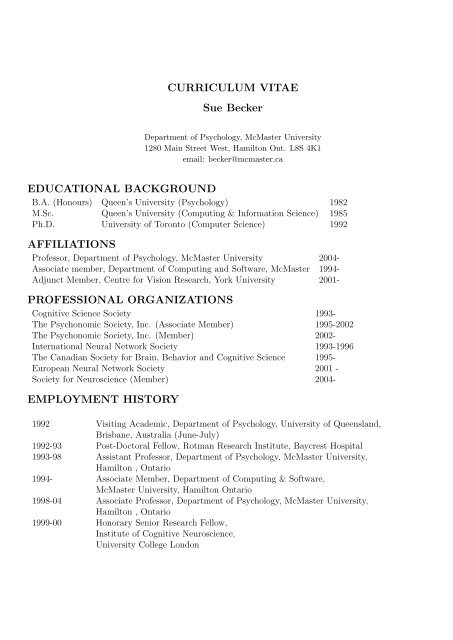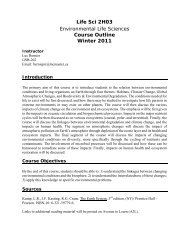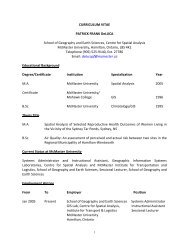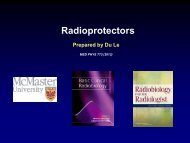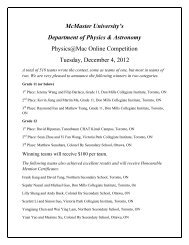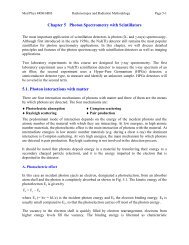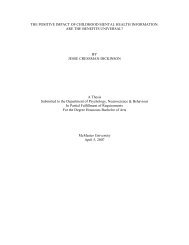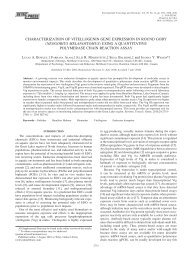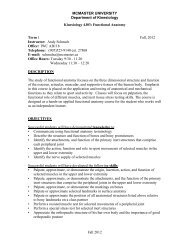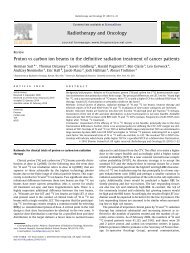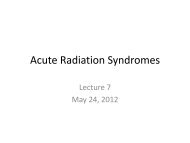CURRICULUM VITAE Sue Becker - Faculty of Science - McMaster ...
CURRICULUM VITAE Sue Becker - Faculty of Science - McMaster ...
CURRICULUM VITAE Sue Becker - Faculty of Science - McMaster ...
You also want an ePaper? Increase the reach of your titles
YUMPU automatically turns print PDFs into web optimized ePapers that Google loves.
<strong>CURRICULUM</strong> <strong>VITAE</strong><br />
<strong>Sue</strong> <strong>Becker</strong><br />
Department <strong>of</strong> Psychology, <strong>McMaster</strong> University<br />
1280 Main Street West, Hamilton Ont. L8S 4K1<br />
email: becker@mcmaster.ca<br />
EDUCATIONAL BACKGROUND<br />
B.A. (Honours) Queen’s University (Psychology) 1982<br />
M.Sc. Queen’s University (Computing & Information <strong>Science</strong>) 1985<br />
Ph.D. University <strong>of</strong> Toronto (Computer <strong>Science</strong>) 1992<br />
AFFILIATIONS<br />
Pr<strong>of</strong>essor, Department <strong>of</strong> Psychology, <strong>McMaster</strong> University 2004-<br />
Associate member, Department <strong>of</strong> Computing and S<strong>of</strong>tware, <strong>McMaster</strong> 1994-<br />
Adjunct Member, Centre for Vision Research, York University 2001-<br />
PROFESSIONAL ORGANIZATIONS<br />
Cognitive <strong>Science</strong> Society 1993-<br />
The Psychonomic Society, Inc. (Associate Member) 1995-2002<br />
The Psychonomic Society, Inc. (Member) 2002-<br />
International Neural Network Society 1993-1996<br />
The Canadian Society for Brain, Behavior and Cognitive <strong>Science</strong> 1995-<br />
European Neural Network Society 2001 -<br />
Society for Neuroscience (Member) 2004-<br />
EMPLOYMENT HISTORY<br />
1992 Visiting Academic, Department <strong>of</strong> Psychology, University <strong>of</strong> Queensland,<br />
Brisbane, Australia (June-July)<br />
1992-93 Post-Doctoral Fellow, Rotman Research Institute, Baycrest Hospital<br />
1993-98 Assistant Pr<strong>of</strong>essor, Department <strong>of</strong> Psychology, <strong>McMaster</strong> University,<br />
Hamilton , Ontario<br />
1994- Associate Member, Department <strong>of</strong> Computing & S<strong>of</strong>tware,<br />
<strong>McMaster</strong> University, Hamilton Ontario<br />
1998-04 Associate Pr<strong>of</strong>essor, Department <strong>of</strong> Psychology, <strong>McMaster</strong> University,<br />
Hamilton , Ontario<br />
1999-00 Honorary Senior Research Fellow,<br />
Institute <strong>of</strong> Cognitive Neuroscience,<br />
University College London
AREAS OF INTEREST<br />
Computational neuroscience, cognitive modelling, cortical reorganization during perceptual development<br />
and after neuronal injury including hearing loss and tinnitus, visual processing, unsupervised<br />
learning, human memory, amnesia, priming, hippocampally-dependent memory, frontal control <strong>of</strong><br />
memory, spatial memory, spatial navigation, computational neuroscience, signal processing applications<br />
<strong>of</strong> neural networks including image and speech compression, hearing compensation algorithms.<br />
HONOURS<br />
NSERC Women’s <strong>Faculty</strong> Award, covering 80% <strong>of</strong> salary 1993-1998<br />
SUPERVISORSHIPS<br />
Post-doctoral Fellows:<br />
Fellow Year Project Current position<br />
Steve Joordens 1996 Long-term semantic priming Assist.Pr<strong>of</strong>.,U <strong>of</strong> T<br />
Andrew Smith 2002- Models <strong>of</strong> dopamine and PDF<br />
schizophrenia<br />
Melissa Dominguez 2003- Models <strong>of</strong> cortical Research<br />
reorganization in tinnitus Associate<br />
Graduate Theses:<br />
Student Year Program Thesis/Project Title<br />
Ken Seergobin 1993- MSc Unsupervised learning: the impact <strong>of</strong><br />
1996 (Psych) temporal and spatial coherence on the<br />
formation <strong>of</strong> visual representations<br />
Chris Lesner 1996- MSc Multi-resolution mixtures <strong>of</strong><br />
1999 (C&IS) principal components<br />
Arnold Liwanag 1996- MSc Learning with multiple<br />
(Psych) co-operating agents<br />
Jean Lim 1997- MSc Learning and consolidation<br />
-2000 (Psych) in the hippocampus<br />
Gaurav Patel 1997- MEng Modelling nonlinear dynamics with extended<br />
2000 (ECE) Kalman filter trained recurrent multilayer<br />
perceptrons (with Haykin & Racine)<br />
Steve Howell 1998-04 PhD Developmental models <strong>of</strong><br />
(Psych) language learning<br />
Damian Jancowicz 1998- PhD Modeling Semantic Category-Specific<br />
(Psych) Deficits Using Topographic,<br />
Corpus-Derived Representations<br />
Chris Gilbert 2001- PhD Models and empirical studies <strong>of</strong><br />
(Psych) strategic memory use<br />
Patrick Byrne 2002- PhD Models and empirical studies <strong>of</strong><br />
(Psych) Spatial cognition<br />
Jeff Bondy 2003- PhD Intelligent hearing aids (with Haykin)<br />
(ECE)<br />
Undergraduate Theses:
Student Year Program Thesis/Project Title<br />
Stephen Holik 1995-96 BSc (Honours A neural network model <strong>of</strong><br />
Psychology) episodic memory<br />
Rick Taylor 1995-96 BSc (Honours Filtering and tuning by<br />
Psychology) neocortex-thalamus complex<br />
Ken Jobity 1995-96 BSc (Honours Neural networks for<br />
Psychology) medical image compression<br />
Sara Page 1996-97 BSc (Honours The impact <strong>of</strong> temporal coherence<br />
Psychology) on the formation <strong>of</strong> visual<br />
representations<br />
Keisha Edwards, 1996-97 BSc (Computing The Web Test Generator<br />
Savraj Malhotra & & Info <strong>Science</strong>s) (4MP6/4ZP6 group project,<br />
Rajesh Sookhoo jointly supervised by R. Racine)<br />
Ted Meeds 1997-98 BSc Local cost functions in a cascading<br />
(Neur. auto-encoder: A neural network model<br />
Comp.) <strong>of</strong> the hippocampal memory system<br />
Adeline Chin 1998-99 BSc (Honours Fast learning in the hippocampus<br />
Neur.Comp.)<br />
Marcia Cushing 1998-99 BSc (Honours An associative model <strong>of</strong> arithmetic<br />
Psychology)<br />
Pat O’Banion 2001- BSc (Honours Algorithms for intelligent hearing aids<br />
Neur.Comp.<br />
Andrew Chan 2002-03 BSc (Honours Models <strong>of</strong> dopaminergic modulation<br />
Neur.Comp.<br />
Psychology)<br />
Jordan Hoath 2002-03 BSc (Honours Investigations <strong>of</strong> strategic memory<br />
Psychology)<br />
Cindy Narinesingh 2003- BSc (Honours Models <strong>of</strong> human memory<br />
Neur.Comp.<br />
Shilpy Gupta 2003-04 BSc (Honours Models <strong>of</strong> human memory<br />
Neur.Comp.<br />
Rohini Kalia 2004-05 BSc (Honours Models <strong>of</strong> contextual condidtioning<br />
Psychology)<br />
Lorie Giles 2004-05 BSc (Honours VR studies <strong>of</strong> spatial memory<br />
Psychology)<br />
Kianosh Keyvani 2004-05 BSc (Honours Models <strong>of</strong> spatial memeory<br />
Psychology)<br />
Josee Yang 2004-05 BSc (Honours Models <strong>of</strong> ECT, kindling, neurogenesis<br />
Psychology)<br />
HaeMin Han 2004-05 BSc (Honours Models <strong>of</strong> hippocampal-PFC gating<br />
Psychology)
RESEARCH FUNDING<br />
Note: MPCN = McDonnell-Pew Program in Cognitive Neuroscience.<br />
1992-93 MPCN A Connectionist Account <strong>of</strong> the Implicit-Explicit Memory $127,169<br />
Distinction (post-doctoral training grant to S. <strong>Becker</strong>)<br />
1993-95 MPCN A Connectionist Account <strong>of</strong> the Implicit-Explicit Memory $39,600/yr<br />
Distinction (research grant to S. <strong>Becker</strong> (P.I.),<br />
M. Moscovitch & M. Behrmann)<br />
1993 NSERC High-Speed Workstations (equipment grant to S. <strong>Becker</strong>) $25,643<br />
1993-96 NSERC Neural Network Models <strong>of</strong> Human Learning $22,000/yr<br />
& Memory (research grant to S. <strong>Becker</strong>)<br />
1996-2000 NSERC Neural Network Models <strong>of</strong> Human Learning $25,000/yr<br />
& Memory (research grant to S. <strong>Becker</strong>)<br />
1996-99 NSERC The effects <strong>of</strong> altered connectivity on interneuronal<br />
communication (Collaborative grant to R. Racine (PI), $86,000/yr<br />
S. <strong>Becker</strong>, S. Haykin, & G. Gerstein)<br />
2000-03 NSERC Intelligent hearing aid systems $165,400/yr<br />
(Collaborative research opportunities grant to S. Haykin<br />
(PI),S. <strong>Becker</strong>, L. Trainor, J.Platt & R.Racine)<br />
2000-04 NSERC Neural network models <strong>of</strong> learning & memory $25,000/yr<br />
(research grant to S. <strong>Becker</strong>)<br />
2002-07 CIHR Understanding, treating and preventing tinnitus $229,200/yr<br />
(New Emerging Teams grant to L. Roberts (PI),<br />
S. <strong>Becker</strong>, J. Eggermont, C. Pantev, I. Bruce, L. Ward)<br />
2002-07 CIHR The development <strong>of</strong> an integrated computational $242,000/yr<br />
neuroscience to understand human mental function<br />
(New Emerging Teams grant to A.R. McIntosh (PI),<br />
S. <strong>Becker</strong>, S. Kapur, M. Henkelman, S. Graham,<br />
P. Fletcher, R. Zemel, R. Dembo)<br />
2002-05 OMHF Decoding Schizophrenia: putting the pieces together: $320,000/yr<br />
Linking Genes, Neurochemistry, Cognition, Affect and<br />
Neural Networks (Special initiatives grant to S. Kapur<br />
(PI) S. <strong>Becker</strong>, P.Fletcher, P.Seeman and T.Tallerico<br />
2004-07 CIHR Schizophrenia, reward learning and reward prediction<br />
errors - A study using computational models and<br />
event-related fMRI (Operating grant to S. Kapur (PI),<br />
S. <strong>Becker</strong>, D. Mikulis, R. Zipursky) $108,619/yr
PUBLICATIONS<br />
(i) Peer Reviewed Articles:<br />
Under review:<br />
1. <strong>Becker</strong>, S. (submitted) “A principle for hippocampal learning”. Submitted to Hippocampus.<br />
2. Howell, S. R., Jankowicz, D., and <strong>Becker</strong>, S. (submitted), A Model <strong>of</strong> Grounded Language Acquisition:<br />
Do Sensorimotor Features Improve Grammar Learning? Submitted to The Journal <strong>of</strong> Memory<br />
and Language.<br />
3. Howell, S. R. and <strong>Becker</strong>, S. (submitted), SRNEngine: A Windows-based neural network simulation<br />
tool for the non-programmer. Submitted to Behavior Research Methods, Instruments, and Computers.<br />
4. Howell, S. R., and <strong>Becker</strong>, S. (Submitted). Grammar from the lexicon: Evidence from neural network<br />
simulations <strong>of</strong> language acquisition, submitted to Cognitive <strong>Science</strong>.<br />
5. Jankowicz, D. and <strong>Becker</strong>, S. (Submitted), “Representation <strong>of</strong> conceptual knowledge: Modeling<br />
category specific deficits using topographic, corpus-derived codes”.<br />
In Press/Published:<br />
1. Smith, A., <strong>Becker</strong>, S. and Kapur, S. (in press), A computational model <strong>of</strong> the selective role <strong>of</strong> the<br />
striatal D2-receptor in the expression <strong>of</strong> previously acquired behaviours. Neural Computation.<br />
2. Byrne, P. and <strong>Becker</strong>, S. (in press), Modelling mental navigation in scenes with multiple objects,<br />
Neural Computation.<br />
3. Trainor, L., Sonnadara, R., Wiklund, K., Bondy, J., Gupta, S., <strong>Becker</strong>, S., Bruce, I. and Haykin,<br />
S. (2004). Development <strong>of</strong> a flexible, realistic hearing in noise test environment (R-HINT-E). Signal<br />
Processing 84:299-309.<br />
4. Smith, A., Li, M., <strong>Becker</strong>, S. and Kapur, S. (2004), A model <strong>of</strong> antipsychotic action in conditioned<br />
avoidance: a computational approach. Neuropsychopharmacology 29(6):1040-9.<br />
5. Haykin, S., Chen, Z. and <strong>Becker</strong>, S. (to appear), Correlation: Novel Basis for Statistical Learning<br />
Algorithms. IEEE Transactions on Signal Processing.<br />
6. Bondy, J., <strong>Becker</strong>, S., Bruce, I., Trainor, L. and Haykin. S. (2004), A novel signal processing strategy<br />
for hearing aid design: NeuroCompensation. Signal Processing Volume: 84, Issue: 7, July, 2004, pp.<br />
1239-1253<br />
7. Bondy, J., Bruce, I., <strong>Becker</strong>, S. and Haykin, S. (2004). Predicting Speech Intelligibility from a<br />
Population <strong>of</strong> Neurons. Advances in Neural Processing Systems 16, MIT Press.<br />
8. Chen, Z., Haykin, S. and <strong>Becker</strong>, S. (to appear), Theory <strong>of</strong> Monte Carlo Sampling-Based Alopex<br />
Algorithms For Neural Networks, Proceedings <strong>of</strong> the IEEE International Conference on Acoustics,<br />
Speech and Signal Processing, 2004.
9. <strong>Becker</strong>, S. and Lim, J. (2003), “A computational model <strong>of</strong> prefrontal control in free recall: strategic<br />
memory use in the California Verbal Learning Task”. Journal <strong>of</strong> Cognitive Neuroscience 15(6):1-12.<br />
10. <strong>Becker</strong>, S. and Zemel, R.(2003), “Unsupervised learning with global objective functions, in The<br />
Handbook <strong>of</strong> Brain Theory and Neural Networks, Second Edition, M. Arbib (ed), La Jolla, CA: MIT<br />
Press.<br />
11. Smith, A., <strong>Becker</strong>, S. and Kapur, S. (2003). From dopamine to psychosis: A computational approach.<br />
Proceedings <strong>of</strong> the 7th International Conference on Knowledge-Based Intelligent Information & Engineering<br />
Systems, St Anne’s College, University <strong>of</strong> Oxford, U.K.<br />
12. Stoianov, I., Zorzi, M., <strong>Becker</strong>, S. and Umilta, C. (2002), “Associative arithmetic with Boltzmann<br />
Machines: The role <strong>of</strong> number representations”. Proceedings <strong>of</strong> the International Conference on<br />
Artificial Neural Networks.<br />
13. <strong>Becker</strong>, S., Chan, A., Fletcher, P. and Kapur, S. (2002), A computational network model <strong>of</strong> the<br />
neural circuits subserving motivated behaviours, Biological Psychiatry, 51:130S.<br />
14. Chen, H., Yao, D., <strong>Becker</strong>, S., Zhuo, Y., Zeng, M. and Chen, L. (2002), A new method for fMRI<br />
data processing: Neighborhood independent component correlation algorithm and its preliminary<br />
application, <strong>Science</strong> in China, Series F, Volume 45, Number 5.<br />
15. Burgess, N., <strong>Becker</strong>, S., King, J. and O’Keefe (2001), Memory for events and their spatial context:<br />
models and experiments, Philosophical Transactions <strong>of</strong> the Royal Society <strong>of</strong> London B, 356:1493-1503.<br />
Also appeared in A. Baddeley, M. Conway and J. Aggleton (editors), Episodic Memory: New Directions<br />
in research, Oxford University Press, 2002.<br />
16. <strong>Becker</strong>, S. and Burgess, N. (2001), Modelling spatial recall, mental imagery and neglect, Advances<br />
in Neural Processing Systems 13:96-102, Todd Leen, Tom Dietterich, Volker Tresp (eds), MIT Press.<br />
17. Howell, S. and <strong>Becker</strong>, S. (2001), “Modelling language acquisition: Grammar from the lexicon?”,<br />
Proceedings <strong>of</strong> the cognitive science society, 2001.<br />
18. Howell, S., <strong>Becker</strong>, S. and Jankowicz, D. (2001), “Modelling language acquisition: Lexical grounding<br />
through perceptual features”, Proceedings <strong>of</strong> the 2001 Workshop on Developmental Embodied<br />
Cognition (DECO-2001).<br />
19. Yao, D., Chen, H., <strong>Becker</strong>, S., Zhou, T., Zhuo, Y. and Chen, L. (2001), “A fMRI data analysis<br />
method using a fast infomax-based ICA algorithm”, IEEE Canadian Conference on Electrical and<br />
Computer Engineering ( IEEE CCECE) 2001.<br />
20. Stevens, C., <strong>Becker</strong>, S. and Trainor, L. (2000), “A Pitch in Time: An Artificial Neural Network Model<br />
<strong>of</strong> Melodic Expectancy”, Cognitive <strong>Science</strong> in Australia, 2000: Proceedings <strong>of</strong> the Fifth Biennial<br />
Conference <strong>of</strong> the Australasian Cognitive <strong>Science</strong> Society.<br />
21. Christianson, G.B. and <strong>Becker</strong>, S. (1999), “A Model for Associative Multiplication”, Advances in<br />
Neural Information Processing Systems 12.<br />
22. <strong>Becker</strong>, S. (1999), “Implicit learning in 3D object recognition: The importance <strong>of</strong> temporal context”,<br />
Neural Computation, 11(2):347-374.
23. <strong>Becker</strong>, S. and Hinton, G. E. (1999), “Learning Mixture Models <strong>of</strong> Spatial Coherence”, in Unsupervised<br />
Learning, Foundations <strong>of</strong> Neural Computation, MIT Press.<br />
24. <strong>Becker</strong>, S., Moscovitch, M., Behrmann, M. and Joordens, S. (1997), “Long-term semantic priming:<br />
A computational account and empirical evidence”, Journal <strong>of</strong> Experimental Psychology: Learning,<br />
Memory and Cognition, Vol. 24, No. 5, pp. 1059-1082.<br />
25. Joordens, S. and <strong>Becker</strong>, S. (1997) “The long and short <strong>of</strong> semantic priming effects in lexical decision”,<br />
Journal <strong>of</strong> Experimental Psychology: Learning, Memory and Cognition, Vol. 24, No. 5, pp. 1083-<br />
1105.<br />
26. <strong>Becker</strong>, S. (1997), “Learning temporally persistent hierarchical representations”. in Advances in<br />
Neural Information Processing Systems 9, M. Mozer, M. Jordan and T. Petsche (eds), MIT Press,<br />
pages 824-830.<br />
27. Liwanag, A. and <strong>Becker</strong>, S. (1997), “Improving Associative Memory Capacity: One-Shot Learning<br />
in Multilayer Hopfield Networks”. Proceedings the 19th Annual Conference <strong>of</strong> the Cognitive <strong>Science</strong><br />
Society, pages 442-447.<br />
28. <strong>Becker</strong>, S. and Plumbley, M. (1996), “Unsupervised neural network learning procedures for feature<br />
extraction and classification, ” in Applied Intelligence, special issue on neural networks, Vol. 6, No.<br />
3, pp. 185-205.<br />
29. <strong>Becker</strong>, S. (1996), “Mutual Information Maximization: Models <strong>of</strong> Cortical Self-Organization”. Network:<br />
Computation in Neural Systems, 7:7-31.<br />
30. <strong>Becker</strong>, S. (1995), “Unsupervised learning with global objective functions, in The Handbook <strong>of</strong> Brain<br />
Theory and Neural Networks, M. Arbib (ed), La Jolla, CA: MIT Press.<br />
31. <strong>Becker</strong>, S. (1995), “JPMAX: Learning to recognize moving objects as a model-fitting problem”, in<br />
Advances in Neural Information Processing Systems 7, Tesauro, G., Touretzky, D. and Leen, T. (eds),<br />
MIT Press, pages 933-940.<br />
32. Chapman, C.A. and <strong>Becker</strong>, S. (1994), “Model synapses with frequency potentiation characteristics<br />
can cooperatively enhance Hebbian learning,” Proceedings <strong>of</strong> the 3rd Annual Computation in Neurons<br />
and Neural Systems Meeting, Boston, MA: Kluwer Academic Publishers.<br />
33. <strong>Becker</strong>, S., Behrmann, M. and Moscovitch, M. (1993), “Word priming in attractor networks”, Proceedings<br />
<strong>of</strong> the Fifteenth Annual Conference <strong>of</strong> the Cognitive <strong>Science</strong> Society, Hillsdale, NJ: Lawrence<br />
Erlbaum Associates, pp. 231-236.<br />
34. <strong>Becker</strong>, S. (1993), “Learning to categorize objects using temporal coherence”, in Giles, C.L., Hanson,<br />
S.J. and Cowan, J.D. (eds.), Advances in Neural Information Processing Systems 5, pp. 361-368, San<br />
Mateo, CA: Morgan Kaufmann Publishers. (full paper)<br />
35. <strong>Becker</strong>, S. and Hinton, G. E. (1993), “Learning mixture models <strong>of</strong> spatial coherence,” Neural Computation,<br />
Vol. 5, No. 2, pp. 267-277.<br />
36. <strong>Becker</strong>, S. and Hinton, G. E. (1992), “A self-organizing neural network that discovers surfaces in<br />
random-dot stereograms,” Nature, Vol. 355, pp. 161-163.
37. <strong>Becker</strong>, S. and Hinton, G. E. (1992), “Learning to make coherent predictions in domains with discontinuities,”<br />
in Advances in Neural Information Processing Systems 4, pp. 372-379, Morgan Kaufmann<br />
Publishers.<br />
38. <strong>Becker</strong>, S. (1991), “Unsupervised learning procedures for neural networks,” International Journal Of<br />
Neural Systems, Vol. 2, No. 1&2, pp. 17-33.<br />
39. <strong>Becker</strong>, S. and le Cun, Y. (1988), “Improving the convergence <strong>of</strong> back-propagation learning with<br />
second-order methods,” Proceedings <strong>of</strong> the 1988 Connectionist Models Summer School, Morgan Kaufmann<br />
Publishers, D. S. Touretzky, G. E. Hinton and T. J. Sejnowski (eds). Also appeared as University<br />
<strong>of</strong> Toronto Connectionist Research Group Technical Report CRG-TR-88-5.<br />
40. Crawford, R.G. and <strong>Becker</strong>, H.S. (1985), “Toward the development <strong>of</strong> interfaces for untrained users,”<br />
Proceedings <strong>of</strong> the American Society for Information <strong>Science</strong>, Las Vegas, Nevada, Vol 22, pp. 236-23.<br />
(ii) Peer Reviewed Abstracts:<br />
1. <strong>Becker</strong>, S. and Wojkowicz, J.M. (to appear), A role for hippocampal neurogenesis in retention <strong>of</strong><br />
long-term memories: evidence from computational modelling. To appear, Proceedings <strong>of</strong> the 2004<br />
Society for Neuroscience Meeting.<br />
2. Dominguez, M., <strong>Becker</strong>, S. and Bruce, I. (2004), “Modelling Cortical Reorganization in Tinnitus”,<br />
Proceedings <strong>of</strong> the 2004 Computational and Systems Neuroscience meeting.<br />
3. <strong>Becker</strong>, S., Chan, A., Fletcher, P., Smith, A. and Kapur, S. (2003), “A computational model <strong>of</strong> the<br />
role <strong>of</strong> dopamine and psychotropic drugs in modulating motivated action”. Schizophrenia Research<br />
60(1) Supplement: Abstracts <strong>of</strong> th IXth International Congress on Schizophrenia Research, page 164.<br />
4. Howell, S., <strong>Becker</strong>, S. and Jankowicz, D. (2003), “A Model <strong>of</strong> Sensorimotor Grounding in Lexical<br />
Learning”. Proceedings <strong>of</strong> the Brain, Behaviour and Cognitive <strong>Science</strong> conference.<br />
5. Jankowicz, D., <strong>Becker</strong>, S. and Howell, S. (2003), “Modeling Semantic Category-Specific Deficits Using<br />
Topographic, Corpus-Derived Representations”. Proceedings <strong>of</strong> the Brain, Behaviour and Cognitive<br />
<strong>Science</strong> conference (abstract). Also to appear in the Proceedings <strong>of</strong> the 44th Annual Meeting <strong>of</strong> the<br />
Psychonomics Society.<br />
6. Chun, S., Campos, J., Chan, G., <strong>Becker</strong>, S., Burgess, N. and Sun, H.-J. (2003), “Viewpoint Dependency<br />
in the Perception <strong>of</strong> Multi-Object Layout”, Proceedings <strong>of</strong> the Brain, Behaviour and Cognitive<br />
<strong>Science</strong> conference.<br />
7. Gilbert, C. and <strong>Becker</strong>, S. (2003), “Semantic Strategies in Free Recall”, Proceedings <strong>of</strong> the Brain,<br />
Behaviour and Cognitive <strong>Science</strong> conference.<br />
8. <strong>Becker</strong>, S., Chan, A., Fletcher, P. and Kapur, S. (2002), “A computational network model <strong>of</strong> the<br />
neural circuits subserving motivated behaviours”, Society for Biological Psychiatry, Philadelphia,<br />
May, 2002.<br />
9. <strong>Becker</strong>, S. (2002), “Strategic Learning and the Control <strong>of</strong> Memory”, Proceedings <strong>of</strong> the Psychonomics<br />
Society Meeting.
10. Howell, S. and <strong>Becker</strong>, S. (2000), “Modelling language acquisition at multiple temporal scales”,<br />
Proceedings <strong>of</strong> the Cognitive <strong>Science</strong> Socitey meeting.<br />
11. Lim, J.C. and <strong>Becker</strong>, S. (2000), “A Reinforcement Learning Application to Free Recall Clustering”,Proceedings<br />
<strong>of</strong> the Cognitive <strong>Science</strong> Socitey meeting.<br />
(iii) Patents<br />
1. Haykin, S., <strong>Becker</strong>, S., Bruce, I., Bondy, J., Trainor, L. and Racine, R.J. (Submitted), Binaural<br />
Adaptive Hearing System. UNITED STATES PROVISIONAL PATENT APPLICATION.<br />
(iv) Not Peer Reviewed:<br />
1. Bondy, J., Bruce, I., <strong>Becker</strong>, S. and Haykin, S. (2003), Applications for modeling <strong>of</strong> intelligibility<br />
<strong>of</strong> sensorineural hearing loss. 37th Asilomar Conference on Signals, Systems, and Computers, 2003.<br />
Invited paper.<br />
2. Bruce, I., Bondy, J., Haykin, S. and <strong>Becker</strong>, S. (2002), “A Physiologically Based Predictor <strong>of</strong> Speech<br />
Intelligibility”, International Conference on Hearing Aid Research (abstract).<br />
3. Bondy, J., Lopez-Risueqo, G., Haykin, S., Bruce, I. and <strong>Becker</strong>, S. (2002), “Automatic Identification<br />
and Individualized Phonemic Processing”, International Conference on Hearing Aid Research<br />
(abstract).<br />
4. <strong>Becker</strong>, S. and Bruce, I. (2002), “Neural coding in the auditory periphery: Insights from physiology<br />
and modelling lead to a novel hearing compensation algorithm”, Workshop on Neural Information<br />
Coding, Les Houches France, March, 2002 (abstract).<br />
5. Patel, G.S., <strong>Becker</strong>, S. and Racine, R. (2001), “2D Image Modelling as a Time Series Prediction<br />
Problem”, in Kalman filtering applied to neural networks, S. Haykin (editor), J. Wiley and Sons.<br />
6. <strong>Becker</strong>, S. (2000) “The hippocampus as a multi-layer learning circuit: Seeing beyond the Hebb rule”,<br />
NICE 2000 - Learning and Neural Plasticity: Theoretical and Experimental Approaches workshop,<br />
Grindelwald, Switzerland (abstract).<br />
7. Cheung, A., <strong>Becker</strong>, S. and Burgess, N. (2000), “A model <strong>of</strong> hippocampal-parietal interaction in<br />
spatial navigation, imagery and episodic recall”, workshop on The nature <strong>of</strong> hippocampal-cortical<br />
interaction: Theoretical and experimental perspectives (abstract), Dublin, Ireland.<br />
8. <strong>Becker</strong>, S., Chin, S. and Meeds, E. (1999), “Modelling episodic memory: A global cost function<br />
that leads to fast, local, high-capacity learning”, Proceedings <strong>of</strong> the Learning workshop (abstract),<br />
Snowbird, Utah, April, 1999.<br />
9. <strong>Becker</strong>, S. and Liwanag, A. (1997),“One-shot learning in Hopfield networks with hidden units”,<br />
Proceedings <strong>of</strong> the Machines That Learn workshop (abstract), Snowbird, Utah.<br />
10. <strong>Becker</strong>, S. (1996), “An unsupervised classifier modulated by temporal history outperforms recurrent<br />
back-propagation in face recognition”, Proceedings <strong>of</strong> the Machines That Learn workshop (abstract),<br />
Snowbird, Utah.
11. <strong>Becker</strong>, S. (1995), “Unsupervised learning <strong>of</strong> population codes as a joint density fitting problem”,<br />
Proceedings <strong>of</strong> the Neural Networks for Computing workshop (abstract), Snowbird, Utah.<br />
12. <strong>Becker</strong>, S. and Hinton, G. E. (1995), “Spatial coherence as an internal teacher for a neural network,”<br />
in Backpropagation: Theory, Architectures, and Applications, Y. Chauvin and D. Rumelhart (eds),<br />
part <strong>of</strong> the series Developments in Connectionist Theory, Lawrence Erlbaum: Hillsdale, NJ. Also<br />
appeared as University <strong>of</strong> Toronto Connectionist Research Group Technical Report CRG-TR-89-7.<br />
13. Roberts, L.E., Racine, R.J., Durlach, P. and <strong>Becker</strong>, S. (1994), “Tuning and filtering in associative<br />
learning”, in Oscillatory event-related brain dynamics, C. Pantev, T. Elbert and B. Lutkenhoner<br />
(eds), Plenum Press.<br />
14. Hinton, G. E. and <strong>Becker</strong>, S. (1992), “Using coherence assumptions to discover the underlying causes<br />
<strong>of</strong> the sensory input,” In S. Davis (Ed.) Connectionism: Theory and practice, New York: Oxford<br />
University Press, pages 3-29.<br />
15. Hinton, G. E. and <strong>Becker</strong>, S. (1990), “An unsupervised learning procedure that discovers surfaces<br />
in random-dot stereograms,” Proceedings <strong>of</strong> the International Joint Conference on Neural Networks,<br />
Vol. 1, pp. 218-222, Lawrence Erlbaum Associates, Hillsdale, NJ.<br />
PRESENTATIONS AT MEETINGS: ( ∗∗ : also listed under Proceedings <strong>of</strong> Meetings)<br />
i) Invited:<br />
1. Workshop on New Directions for Signal Processing in the 21st Century, Lake Louise, Alberta, October<br />
5-10, 2003.<br />
2. Computational Mechanisms in the Generation and Treatment <strong>of</strong> Tinnitus, Workshop on Understanding<br />
and Treating Tinnitus, Peter Wall Institute, Vancouver B.C. November, 2003.<br />
3. Modelling Cortical Reorganization in Tinnitus, Workshop on Tinnitus Modelling, Niagara-on-thelake,<br />
April, 2003.<br />
4. “Computational models <strong>of</strong> neural coding in the hippocampus”, Workshop on Computational Neuroscience:<br />
Levels <strong>of</strong> Modelling, Fields Institute, Toronto, October 21, 2002.<br />
5. “Connectionist models <strong>of</strong> controlled memory search: Successes, challenging data, and future directions”,<br />
Symposium on Models <strong>of</strong> Context, Orlando, Florida, November, 2002.<br />
6. “Computational models <strong>of</strong> neural coding explain robust, rapid memory formation and neurogenesis in<br />
the hippocampus”, Symposium on Interdisciplinary Approaches to Neuroscience: The Hippocampus,<br />
Kalamazoo College, Michigan, April 2002.<br />
7. “Neural coding in the auditory periphery: Insights from physiology and modelling lead to a novel<br />
hearing compensation algorithm”, Workshop on Neural Information Coding, Les Houches France,<br />
March, 2002. ∗∗<br />
8. “A Model <strong>of</strong> Strategic Memory Access: Prefrontal Involvement in the California Verbal Learning<br />
Task”, Workshop on Connectionist Neuropsychology, Whistler, B.C., December, 2001.
9. “The hippocampus as a multi-layer learning circuit: Seeing beyond the Hebb rule”, NICE2000 workshop<br />
on Learning and Neural Plasticity: Theoretical and Experimental Approaches, Grindelwald,<br />
Switzerland. March, 2000. ∗∗<br />
10. “Modelling episodic memory: A global cost function that leads to fast, local, high-capacity learning”<br />
Workshop on Learning, Snowbird, Utah. April, 1999. ∗∗<br />
11. “Modelling expectancy and translation-invariance in musical sequence processing”, Workshop on<br />
Statistical Theories <strong>of</strong> Cortical Function, Breckenridge, Colorado, December, 1998.<br />
12. “Modelling intelligence: In search <strong>of</strong> the brain’s cost function”, Workshop on computational and<br />
biological models <strong>of</strong> intelligence, Seattle WA and Friday Harbour, WA, August 1998.<br />
13. “Implicit and Explicit Learning: What computational models can tell us”, Lake Ontario Visionary<br />
Establishment conference, February 1998.<br />
14. “Computations in the hippocampus: From global to local cost functions”, Workshop on Computational<br />
Neuroscience and Generative Models, University <strong>of</strong> Toronto, February 1998.<br />
15. “Context, coherence and cortical computations”, MRC research group workshop on brain mapping<br />
and cortical plasticity, Vineland, Ontario, June, 1997.<br />
16. “One-shot learning in Hopfield networks with hidden units”, Machines That Learn workshop, Snowbird,<br />
Utah, April 1997. ∗∗<br />
17. “An unsupervised classifier modulated by temporal history outperforms recurrent back-propagation<br />
in face recognition”, Machines That Learn workshop, Snowbird, Utah, April 1996. ∗∗<br />
18. “Unsupervised learning and vision I & II”, Spring Workshop on Artificial Neural Networks, University<br />
<strong>of</strong> Montreal, two invited lectures, April, 1996.<br />
19. “Computational and empirical evidence for temporal persistence as a cue in perceptual learning”,<br />
McDonnell-Pew Program in Cognitive Neuroscience, annual meeting, Wellesley, Maryland, June,<br />
1996.<br />
20. “On the Computational Utility <strong>of</strong> Contextually Modulated Plasticity: A Model, some Empirical Results<br />
and Speculations on Cortical Function”, Workshop on Neural Modulation, Snowmass, Colorado,<br />
December, 1996.<br />
21. “Unsupervised learning <strong>of</strong> population codes as a joint density fitting problem”, Neural Networks for<br />
Computing workshop, Snowbird, Utah, April 1995. ∗∗<br />
22. “Long-term semantic priming in lexical decisions”. Symposium on Computational Approaches to<br />
Modelling Semantic Effects in Word Recognition, BBCS Conference, Halifax, Nova Scotia, June<br />
1995.<br />
23. “Information maximization vs. density estimation: What’s the best cost function for unsupervised<br />
learning?”. Presented at the Workshop on Information Theory and Neural Networks at the 1995<br />
meeting <strong>of</strong> the Neural Information Processing Society in Colorado, December, 1995.<br />
24. “Learning to cluster visual scenes with contextual modulation”. Workshop on Unsupervised Learning<br />
and Vision, at the 6th annual meeting <strong>of</strong> the Neural Information Processing Society, Vale, Colorado,<br />
December, 1994.
25. Workshop on “Unsupervised Learning”, 1993 Connectionist Models Summer School, Boulder, Colorado.<br />
26. “Unsupervised connectionist learning procedures that discover Spatially coherent features <strong>of</strong> the<br />
visual world”, Neural Information Processing Society workshop on Unsupervised Learning and Selforganization<br />
in Vision, Vale, Colorado, December, 1991.<br />
ii) Contributed:<br />
Peer Reviewed:<br />
1. A computational network model <strong>of</strong> the neural circuits subserving motivated behaviours”, Contributed<br />
poster presented (refereed), Society for Biological Psychiatry. May 2002.<br />
2. “Strategic Learning and the Control <strong>of</strong> Memory”, Psychonomics Society Meeting, Kansas City, MO,<br />
November, 2002<br />
3. “A computational network model <strong>of</strong> the neural circuits subserving motivated behaviours”, Society<br />
for Biological Psychiatry, Philadelphia, May, 2002. Contributed. ∗∗<br />
4. “A model <strong>of</strong> hippocampal-parietal interaction in spatial navigation, imagery and episodic recall”,<br />
workshop on The nature <strong>of</strong> hippocampal-cortical interaction: Theoretical and experimental perspectives<br />
Dublin, Ireland. March, 2000. ∗∗<br />
5. “Improving Associative Memory Capacity: One-Shot Learning in Multilayer Hopfield Networks”. Selected<br />
for oral presentation at the 19th Annual Conference <strong>of</strong> the Cognitive <strong>Science</strong> Society, Stanford,<br />
CA, August, 1997. ∗∗<br />
6. “Learning temporally persistent hierarchical representations”, Neural Information Processing Systems<br />
9, Denver Colorado, 1996. ∗∗<br />
7. “JPMAX: Learning to recognize moving objects as a model-fitting problem”, Neural Information<br />
Processing Systems 7, Denver, Colorado, 1994. ∗∗<br />
8. “Model synapses with frequency potentiation characteristics can cooperatively enhance Hebbian<br />
learning,” 3rd Annual Computation in Neurons and Neural Systems Meeting, Boston, Mass., 1994. ∗∗<br />
9. “Word priming in attractor networks”, Fifteenth Annual Conference <strong>of</strong> the Cognitive <strong>Science</strong> Society,<br />
Pittsburgh, PA, 1993. ∗∗<br />
10. “Learning to categorize objects using temporal coherence”, Neural Information Processing Systems<br />
5, Denver, Colorado, 1992. ∗∗<br />
11. “Learning to make coherent predictions in domains with discontinuities,” Neural Information Processing<br />
Systems 4, Denver, Colorado, 1991. ∗∗<br />
Not Peer Reviewed:<br />
1. “Computations in the hippocampus: From global to local cost functions”, Workshop on Computational<br />
models <strong>of</strong> episodic memory and hippocampal function, Breckenridge, Colorado, December<br />
1997.
2. “Long-term semantic priming in lexical decisions”, Psychonomics Society Meeting, 1995.<br />
INVITED SEMINARS:<br />
1. “A computational model <strong>of</strong> encoding and neurogenesis in the hippocampus, Hippocampal Neurogenesis<br />
workshop, Computational Neurosciences conference, Baltimore, July 21-22, 2004 (invited)<br />
2. Computational Models <strong>of</strong> Neural Coding in the Hippocampus, Understanding Complex Systems<br />
Symposium, UIUC, Illinois, May 20, 2004 (invited).<br />
3. “Is cognitive control an uncontrolled process? Insights and confusions from models and memory<br />
experiments.” Cognition/Perception Seminar, Dept Psychology, <strong>McMaster</strong>, September, 2002.<br />
4. “Computing visuo-spatial maps: From visual images to spatial memories and back again”, Centre<br />
for Vision Research, York University, Toronto, Ontario, December, 2001.<br />
5. “Models <strong>of</strong> dopaminergic actions in reinforcement learning, neuromodulation and schizophrenia”,<br />
Schizophrenia Research Seminar, Centre <strong>of</strong> Addiction and Mental Health, Toronto, October, 2001.<br />
6. “Intelligent hearing aid systems: adaptive signal processing and neural model-based approaches”,<br />
July, 2001, BLISS/Intelligent Hearing Aid joint group meeting, Granada, Spain.<br />
7. “A neural model <strong>of</strong> hippocampal-parietal interactions in spatial memory”, February 2, 2001, IGERT<br />
program on Dynamics <strong>of</strong> Complex Systems in <strong>Science</strong> and Engineering, Interdisciplinary Seminar in<br />
Nonlinear <strong>Science</strong>, Northwestern University, Chicago, Illinois.<br />
8. “Hippocampal-parietal networks in imagery and scene recall”, February 28, 2001, Ebbinghaus Empire<br />
Seminar, Department <strong>of</strong> Psychology, University <strong>of</strong> Toronto.<br />
9. “Hippocampal Computations in Memory”, Swiss Federal Institute <strong>of</strong> Technolgy, Lausanne Switzerland,<br />
January, 2000.<br />
10. Implicit learning in 3D object recognition: The importance <strong>of</strong> temporal context, Colloquium for<br />
Neuroinformatics, ETH, Zurich. January, 2000.<br />
11. “A neural model <strong>of</strong> spatial cognition”, Informatics Jamboree, Edinburgh, Scotland, May 2000.<br />
12. “Modelling the hippocampal system: From Hebbian learning to multilayer circuits and back again”,<br />
October 22, 1999, Institute <strong>of</strong> Cognitive Neuroscience, University College London.<br />
13. “What episodic memories are made <strong>of</strong>: Hebbian learning and beyond”, Ebbinghaus Empire seminar,<br />
Department <strong>of</strong> Psychology, University <strong>of</strong> Toronto, March, 1999.<br />
14. “The more you learn the less you know, and other paradoxes in connectionist models <strong>of</strong> human<br />
memory”, Cognitive <strong>Science</strong> seminar, University <strong>of</strong> Arizona, Tucson, February 1997.<br />
15. “Mechanisms <strong>of</strong> learning in the neocortex and hippocampus: What computational models can tell<br />
us”, Rotman Research Institute, Baycrest Hospital, North York, Ont., December 1997.<br />
16. “Contextually Modulated Unsupervised Learning”, Neural Networks Lab, Department <strong>of</strong> Computer<br />
<strong>Science</strong>, University <strong>of</strong> Toronto, February, 1995.
17. “Converting hard learning problems to easy ones with unsupervised neural networks”, Seminar,<br />
Department <strong>of</strong> Computer <strong>Science</strong> and Systems, <strong>McMaster</strong>, April, 1995.<br />
18. “Unsupervised classification using temporal continuity”, Communications Research Lab, <strong>McMaster</strong>,<br />
May, 1995.<br />
19. “Connectionist modelling <strong>of</strong> hippocampal functions” Psychobiology Seminar, Department <strong>of</strong> Psychology,<br />
<strong>McMaster</strong> University, April, 1994.<br />
20. “Unsupervised connectionist learning procedures that discover spatio-temporal regularities in the<br />
visual world”. Cognitive <strong>Science</strong> Seminar, Department <strong>of</strong> Psychology, University <strong>of</strong> Rochester, March,<br />
1994.<br />
21. “Unsupervised learning in neural networks”, Department <strong>of</strong> Computer <strong>Science</strong>, Queen’s University.<br />
22. ”Learning invariant properties <strong>of</strong> sensory signals in neural networks”. Colloquium talk, Department<br />
<strong>of</strong> Computer <strong>Science</strong>, University <strong>of</strong> Central Florida, Orlando, November, 1993.<br />
23. ”A model <strong>of</strong> word priming in attractor networks that makes some novel predictions about human<br />
memory”. Artificial Intelligence Lab, UCSD, February, 1993.<br />
24. ”A model <strong>of</strong> word priming in attractor networks that makes some novel predictions about human<br />
memory”. Connectionist Research Group, Stanford University, February, 1993.<br />
25. “Learning Spatially Coherent Properties Of the Visual World in Connectionist Networks”, Department<br />
<strong>of</strong> Computer <strong>Science</strong>, Queen’s University, 1991.<br />
ADMINISTRATIVE RESPONSIBILITIES<br />
i) Department<br />
Curriculum Committee, Member, 1995-96<br />
Computing Committee, Member, 1994-95<br />
Hiring/Job Search Committee, Member, 1993-94, 2002-2003<br />
Computing Committee, Chair, 1995-<br />
Computer-aided Instruction Committee, Member, 1996-<br />
Undergraduate Student Counselling Comittee, Member, 1998-2000<br />
Undergraduate Curriculum Committee, 2002-<br />
CFI budget/equipment purchase Committee, Member, 2003<br />
ii) <strong>Faculty</strong><br />
Dean’s Advisory Committee on Computing, Member, 1993-94<br />
Social <strong>Science</strong>s Undergraduate Curriculum Committee, Member, 1995-96<br />
Chair Selection Committee, Department <strong>of</strong> Mathematics and Statistics, 1995-96
Steering Committee, Honours Neural Computation Programme, 1995-<br />
Programme Co-ordinator, Honours Neural Computation, 1995-<br />
iii) University<br />
Member, <strong>McMaster</strong>’s Research and High Performance Computing Support (RHPCS) Advisory Committee,<br />
chaired by Hugh Couchman (as <strong>of</strong> May, 2002)<br />
OTHER RESPONSIBILITIES<br />
<strong>Faculty</strong> Member, Connectionist Models Summer School, Boulder CO, 1993<br />
Topic area chair, International Congress <strong>of</strong> Psychology conference, 1995<br />
Member, Organizing committee (Publicity chair), Neural Information Processing Society conference, 1996<br />
Member, Program Committee, Neural Information Processing Society conference, 1997<br />
Member, Organizing committee (Workshops co-chair), Neural Information Processing, 1998-99<br />
Program Chair, Neural Information Processing Society conference, 2000-2001<br />
General Chair, Neural Information Processing Society conference, 2001-2002<br />
Member, Scientific Advisory Board, The Medipattern Corporation, Toronto, 2002-<br />
Member, Provincial panel to rank students for OGS scholarships, 2003<br />
Member, Advisory Board, Neural Information Processing Society conference, 2003-<br />
Member, Five-year Review Committee, RIKEN Brain <strong>Science</strong>s Institute, Creating the Brain section,<br />
2004-2005


